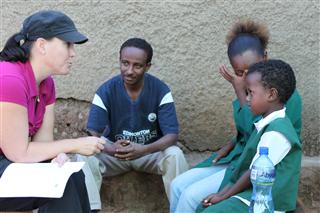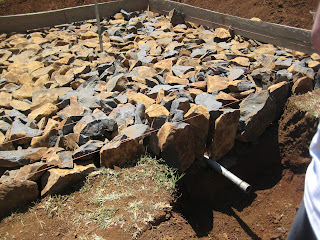Our team went to Merkato today - Africa's largest outdoor market. It was HUGE - the size of a small city! Merkato was a maze teaming with cars, people and donkeys. You can buy anything here: "From false teeth to a camel". If you can drive your vehicle through Merkato - you can drive anywhere! Our driver Mesfin did an awesome job of navigating. He also negotiated our purchases for us.
 |
| Merkato stall. |
 |
| Bulk grains for sale. |
There are 62 families we are helping so we bought 62 bags of wheat flour, 186 liters of palm or vegetable oil and 62 bars of laundry soap. It was interesting that some small shops did not want to sell this amount to us - likely this is because we would clean out their entire inventory but perhaps it was because we are foreigners?
 |
| This stall would not sell us soap...at least they didn't string us along! |
In the shop that we bought the flour, the shop owner brought us stools to sit on which was quite a courtesy. You can imagine the looks when a tiny little shop had 4 foreigners sitting out front! The shop owners also kept the beggars at bay while we waited for our goods to be loaded into our van. They were fantastic hosts.
 |
| Stacks of flour and the helpers who hauled our purchases to the van for us. |
The merkato is a once in a lifetime experience. Where else can you see vendors walking around with twenty mattresses or 15 barrels on their head?
 |
| Try and top this Sleep Country Canada! |
 |
| I bet this guy is a barrel of laughs. |
After our purchases were stored back at Tazina, we visited SSCM. SSCM stands for "Support Street Children & Mothers" and it is now a vocational training center. They teach metal work, wood working and hair dressing.
 |
| Wood working samples of different joining techniques. |
 |
| Metal work trainees hard at work. |
 |
| Hair dressing school. |
Canadian Humanitarian sponsors this organization which was originally started by Japanese and German NGO's from which the funding was pulled. It's a good thing Canadian Humanitarian is helping because many good things are happening at SSCM. They have a 98% job placement rating.
After SSCM we stopped at YTH Kid's Hope Guelele. This project supports an education center where the Canadian Humanitarian sponsored kids gather after school for tutoring and club activities like music, art and circus (gymnastics).
 |
| YTH Guelele education centre, the kids and Deb, Dr. Northcott and Bryce. |
The kids range in age from 7 to 17 and we each got to interview 10 to 15 kids. I love chatting one-on-one with these amazing young people, some through an interpreter. The kids were excited to have their interview, I think it helped make them feel special.
 |
| Bryce and Zanner with some special Guelele kids. |
Their favorite subjects are biology, math, physics and English. They want to be engineers, doctors, pilots, professional soccer players and musicians. What an awesome group of kids!
 |
| Dr. Northcott has inspired many kids who now want to become doctors. |
After a long day, we decided to top it off with a traditional Ethiopian meal at a restaurant called Yod Abyssinia. We entered through a metal detector and two guards at the entrance. When we entered, I noticed it was quite smoky and filled with low tables surrounded by small wooden chairs covered in goat or cow hide. There was a stage with dancing and 5 musicians playing traditional Ethiopian instruments.
 |
| Yod Abyssinia restaurant. |
 |
| Traditional table, similar to a weaved basket. |
|
| The singing and dancing was fantastic! |
Before the meal was served a gentleman stopped by our table with a unique jug and basin . I had no idea what it was or what to do! It turns out that it was to wash our hands before the meal - a very nice touch since Ethiopian meals are traditionally eaten with your fingers.
 |
Deb washing her hands prior to the meal.
Such a nice touch - more Canadian restaurants should offer this! |
We had a traditional meal with vegetables dishes made with chick peas, lentils, spinach, cabbage and potato (referred to as "fasting food"). We shared one non-fasting meat dish called tibs which was tender spicy beef. And I mean tender, it almost melts in your mouth! A new favorite of mine for sure. Many dishes were served on a small charcoal barbecue - hence the smoke in the restaurant. I laughed because the menu described this as "served on fire".
 |
Traditional Ethiopian meal - check out the size of that spicy pepper!
Everyone at your table eats off of the same platter. |
The staple of the Ethiopian diet is injera - a flat bread made from a grain called tef. The bread is similar to a crepe or pancake and is served rolled up. To enjoy your meal you tear off a piece of injera and use it to scoop up the slow cooked dishes that are similar to a stew and are referred to at "wot". Yummy!
One of our team members, Nicole, finally made it to Addis after several delayed flights and missed connections. I was happy to finally meet her and know that she was safe.
 |
| Nicole and Zanner - practically twins! |

























































